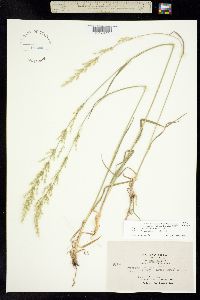Trisetum canescens
|
|
|
|
Family: Poaceae
Tall False Oat, more...tall trisetum, nodding oatgrass, tall oatgrass, Nodding Trisetum
[Trisetum cernuum Trin., moreTrisetum cernuum cernuum , Trisetum cernuum subsp. canescens (Buckl.) Calder & Taylor, Trisetum cernuum subsp. cernuum Trin., Trisetum cernuum var. canescens (Buckl.) Beal, Trisetum cernuum var. projectum (Louis-Marie) Beetle, Trisetum spicatum var. projectum (Louis-Marie) J.T. Howell] |
Plants perennial, sometimes with both fertile and sterile shoots; cespitose, not rhizomatous. Culms 40-120 cm, erect, usually smooth. Leaves 3-4 per culm; sheaths crisped-pubescent to shaggy-pilose, scabrous or smooth; ligules (1.5)3-6 mm, rounded to truncate; blades 10-30 cm long, (3)7-10 mm wide, flat, erect, lax, margins (and occasionally surfaces) sometimes with scattered 1-3 mm hairs. Panicles 10-25 cm long, (0.75)1-3(4) cm wide, narrow, erect or nodding at the apices, green or tan, occasionally purple-tinged; branches 1-5.5 cm, ascending to somewhat divergent, most spikelet-bearing for their full length, sometimes the lowermost branches naked below. Spikelets 7-9 mm, pedicellate, with 2-4 florets; rachilla internodes 1.5-3 mm; rachilla hairs 0.7-1 mm; disarticulation above the glumes and between the florets. Glumes unequal to subequal; lower glumes 3-5 mm, narrow, lanceolate to subulate, acute or long-tapered; upper glumes (3.5)5-7(9) mm long, shorter than the lowest florets, at least twice as wide as the lower glumes, broadly lanceolate to obovate, widest at or below the middle, tapering to the apices, acute; callus hairs about 0.5 mm; lemmas 5-7 mm, glabrous, apices bifid, teeth to 2.5(3.2) mm, setaceous, awned, awns 7-14 mm, arising mostly at the upper 1/3 of the lemmas, geniculate; paleas as long as or slightly longer than the lemmas; anthers 1-3 mm. Caryopses usually to 3 mm, glabrous or finely hairy distally. 2n = 28, 42. Trisetum canescens grows at or near stream banks, and in forest margins or interiors, in moist to dry areas in the western Flora region. It is especially abundant in ponderosa pine stands and spruce-fir forests. The vestiture of different parts varies throughout the range of the species. Plants from California with conspicuously interrupted panicles have been called Trisetum cernuum var. projectum (Louis-Marie) Beetle. Plants perennial, with both fertile and sterile shoots; cespitose, not rhizomatous. Culms (30)50-110 cm, erect, glabrous or pubescent. Leaves 2-3 per culm; sheaths scabridulous or pilose; ligules 1.5-3 mm, truncate, erose to lacerate; blades (8.5)15-20+ cm long, (3)7-12 mm wide, flat, ascending, lax at maturity, often scabridulous. Panicles 10-30 cm long, (1)2-9 cm wide, open, nodding, green or tan, occasionally purple-tinged; branches 2-12+ cm, most, except sometimes the uppermost, spikelet-bearing only towards the apices, with the basal (1/5)1/3-1/2 bare, filiform, flexuous, at least the lowermost 1-3 whorls spreading or drooping. Spikelets 6-12 mm, subsessile to pedicellate, pedicels to 2 cm, usually with 2-3 functional florets below 1-2 reduced florets; rachilla internodes and hairs 1-2.5 mm; disarticulation above the glumes and between the florets. Glumes unequal; lower glumes 0.75-2(3) mm, subulate; upper glumes 3.5-5 mm long, shorter than the lowest florets, 2-3 times as wide as the lower glumes, widest at or above the middle, ovate or obovate, rounded to the acuminate apices; callus hairs to 1 mm; lemmas 5-6 mm, broadly lanceolate, glabrous, bifid, teeth to 1.3 mm, awned, awns (7)9-14 mm, arising from above midlength to just below the teeth, conspicuous, arcuate to flexuous; paleas shorter than the lemmas; anthers about 1 mm. Caryopses about 2.5-3.2 mm, densely to sparsely pubescent. 2n = 42. Trisetum cernuum grows in moist woods, stream banks, lake and pond shores, and floodplains of the western Flora region. The hairiness of the leaf sheaths varies, often within a plant. |


































































































